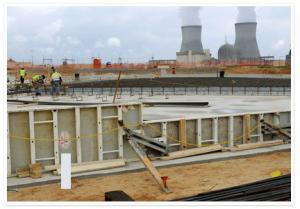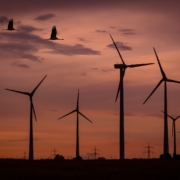Surely We Can Do Better than Nuclear Socialism
by Brent Blackwelder
 They were in the news a half century ago when they were called “too cheap to meter.” Now “absolutely safe” nuclear reactors are once again in the news. As the horrifying scene in Japan unfolds this month, many politicians and media pundits are acting as if the only electricity choice for the U.S. is nuclear reactors or coal power plants. This is a false choice.
They were in the news a half century ago when they were called “too cheap to meter.” Now “absolutely safe” nuclear reactors are once again in the news. As the horrifying scene in Japan unfolds this month, many politicians and media pundits are acting as if the only electricity choice for the U.S. is nuclear reactors or coal power plants. This is a false choice.
A sustainable economy requires a sustainable energy supply, one that is not subject to the vulnerabilities of big central energy systems. A steady state economy would run on a decentralized set of renewable energy sources that is clean and resilient. It would be an economy powered by the sun, the wind, the natural heat content of the Earth, and other renewable sources. Advanced designs for where we live and how we travel would be a key part of this energy transformation. For example, buildings would be designed to generate power rather than requiring external energy supplies for cooling and heating. And let’s not forget about conservation – we need to set up the economy such that it uses less energy in the first place.
The energy system that would run a steady state economy does not have the severe security problems that plague current systems, nor would it require massive subsidies in the form of liability limits, loan guarantees, externalization of health damages, etc. You don’t have to worry about a solar or wind “spill” contaminating the air, land and water; you don’t need liability caps for a wind farm or for solar collectors on roofs; and finally, you don’t need to bill consumers (instead of stockholders or investors) in advance for a nuclear reactor that may never be completed.
The strength and resilience of decentralized power, its superior employment intensity, and the potential for community involvement are all features that make a different energy model very attractive. Various European nations such as Spain, Germany, and Denmark have demonstrated the huge potential of wind and solar power, as has the state of Texas in the case of wind with 9,700 megawatts installed.
 But look at the powerful forces today pushing nuclear reactor construction in the southeastern U.S. and obstructing the clean energy path of the future. Even after the terrible nuclear meltdown in Japan, two big southern utilities, South Carolina Electric & Gas and Georgia Power, announced that they are not pausing to consider some lessons to be learned before proceeding full speed ahead with four new reactors. To pay for two new reactors at Plant Vogtle, Georgia Power has begun billing its Georgia customers this month for the intended construction. Ironically, the proposed new reactors being billed to Georgia consumers are intended to supply customers in Florida. Consumers and taxpayers are bearing all the risks, not investors.
But look at the powerful forces today pushing nuclear reactor construction in the southeastern U.S. and obstructing the clean energy path of the future. Even after the terrible nuclear meltdown in Japan, two big southern utilities, South Carolina Electric & Gas and Georgia Power, announced that they are not pausing to consider some lessons to be learned before proceeding full speed ahead with four new reactors. To pay for two new reactors at Plant Vogtle, Georgia Power has begun billing its Georgia customers this month for the intended construction. Ironically, the proposed new reactors being billed to Georgia consumers are intended to supply customers in Florida. Consumers and taxpayers are bearing all the risks, not investors.
The energy systems used to power the global economy are highly vulnerable to extreme weather events, sabotage, terrorism, and war. The Japanese catastrophe this month certainly brings to mind the nuclear disasters at Chernobyl in 1986 and Three Mile Island in 1979. But the nuclear and fossil fuel industries have supplied many less well-known disasters. A brief review of some of the accidents will accentuate the difference between the polluting energy of today’s economy and the clean energy future that would, by its very nature, avoid these messes:
- In July of 1979, at the Navajo community of Church Rock, New Mexico, an earthen dam at United Nuclear Corporation’s uranium mill broke, releasing 95 million gallons of radioactive wastewater into the Rio Puerco. The spill sent contaminants over 100 miles downstream. This unpublicized spill is estimated to have contained over triple the amount of radiation (curies) that the Three Mile Island nuclear reactor released in the very same year.
- Last year tornado warnings near Detroit forced the shutdown of the Fermi 2 atomic reactor. This was the same site where a meltdown in 1966 nearly irradiated the Greats Lakes Region.
- For much of 2010 the BP oil spill in the Gulf of Mexico was an ongoing saga of futility and despair.
- In July of 2007 a major earthquake in Japan badly damaged one nuclear reactor in a complex of nuclear reactors.
- In December of 2008 a Tennessee Valley Authority reservoir, which was storing the contaminated ash from one of its power plants, burst and sent a toxic stew of waste 100 times larger than the Exxon Valdez oil spill into a tributary of the Tennessee River. Despite assurances that such dam bursting was unusual and would never happen again, scarcely a month had passed when yet another coal waste reservoir (this one in Alabama) failed and spewed contamination downstream.
Vulnerability lessons are not new. After World War II German military leaders pointed out that the U.S. could have ended the War two years sooner by bombing the big coal power plants. Instead the allies were bombing individual industrial sites like steel mills, failing to recognize that the big coal plants powered 80% of Germany’s manufacturing. In contrast, Japan’s electric power was provided by a huge number of small dams that were not attractive targets for attack because no single one was crucial for the power system of the nation.
The energy for a steady state economy can be supplied by a huge number of solar panels and wind mills as outlined by physics professors Jacobson and Delucchi at Stanford University (Scientific American, November, 2009) and by many others. It would be a refreshing change to see President Obama propose such an ambitious solar/wind plan in the aftermath of the meltdown in Japan, but he seems content merely to suggest a thorough review of nuclear reactors.
Before having to hear how high the costs of renewable energy are, I’ll close with a brief reminder of the government subsidies the U.S. nuclear industry is slated to receive. Here are some components of the $46 billion being offered up over the next 5 years in addition to the cap on liability for any accident:
- $22.5 billion in loan guarantees for new reactors;
- $12.3 billion in nuclear waste fund liability payments;
- $3 billion for mixed oxide activities; and
- $1.9 billion for fusion energy.
For more details, please see the green scissors report.
Seeing this list of handouts, one might think that Republican leaders would recoil at what might be termed nuclear socialism. One would think that the Tea Party activists would revolt at the sight of this massive government program to fund something that Wall Street would not touch even before the catastrophe in Japan.


While it may take a bit of rational abstraction to see the connection, the Nuclear “Cove” is an analogy that we can not afford to dismiss from our current mass destructive concerns at hand over Nuclear power dialogue.
THE COVE is an environmental documentary about dolphin slaughter which is an allegorical warning of great proportion. It is a call to action and awareness about the great destruction we are promoting as enterprise. The coincidental fact that it is also centered from Japan is an historical synchronicity, but the merits of its argument apply most directly to the unsustainable “developed” economies of our planet and its unfettered and manic compulsive consumption. It is about a growing desperation in political economies of scale (both negative and positive; diminishing and accelerating: expanding and intensifying) and the less than obvious scope of its effects on the globe.
While the Cove is about the plight of dolphins, It indicates quite nicely how distinct and regionalized people around the world can be pulled into the degradation simply because the cost is not immediately their own and some of the finance can be spread to corrupt the innocent.
This is the same model being employed for the fallacies of distinction concerning our choices for energy supply and research. In the Cove It is a warning about industrial mercury in our food supply and how easily it can get into our children. It is insidious and now ubiquitous for global human culture, yet remains a “background” noise of protest for most of the world at large. Yet, It is analogous to everything we are doing on this planet and may well be, in all its innocence, the true legacy of our arrogant dismissal of smaller scale warnings that are now growing so far out of proportion that it is distorting our very survival instincts themselves.
We have come to believe that we are totally dependent upon the very things that are destroying our future; and destroying our chances of developing technologies that are within the boundaries of cultural and demographic restraints on a time line that will meet our optimum global capacity.
Brent makes a great argument about the problems of nuke power and otherwise. I never knew that about Japan´s wartime power. Small hydro is another fine option, I have learned in recent years, and Europe at least has an association for the technology.
Greenpeace also has at least one great book about a number of nuclear accidents left unreported at large. Union of Concerned Scientists and Greenpeace are at least two groups with interesting reports about the levels of risk that have continued to afflict nuclear power functioning in the US and around the world.
Bruce Woych´s point is also well-taken. I´m very interested in consciousness raising activities, like the Live Earth concert in July, 2007 and the Green Festivals by Green America et al. I think those, along with associations like Slow Food and certifications like organic and fair trade offer real and tangible choices to the consumerized reality most of us live.